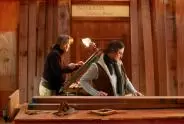Carving Their Own Path
 Originally Published in The Press Democrat by Meg McConahey
Originally Published in The Press Democrat by Meg McConahey
Credit Debey Zito’s high school sewing teacher for setting her on her career path as a fine woodworker.
Zito couldn’t stand the woman. So at 17 she signed up for wood shop, becoming the first girl ever to darken the door of teacher Ben Halpern.
“I knew with women’s lib we were going to get a girl,” she recalled him grumbling on the first day of class.
But he proved to be an important mentor and champion, instilling her with the confidence to push forward in a field almost completely dominated by men who were all too quick to dismiss her.
It wasn’t an easy trail to blaze. Every door she knocked on slammed in her face when she first looked for an internship in a wood shop after high school in the early 1970s. Shop owners warned, “You know what’s going to happen to your fingernails.” She was one of only five women among 500 students in the industrial arts department at San Diego State University.
“I had a professor with a doctorate who asked me if I was there to catch a husband. They didn’t believe I could do it,” she said.
But Zito stubbornly persisted. More than 40 years later she is a respected and seasoned woodworker, designing and building elegant artisan pieces, many inspired by the Arts & Crafts and Art Nouveau movements, and featuring the hand-carving of her longtime partner, Terry Schmitt.
From their workshop and interior design studio in Sebastopol the pair collaborate to design and build heirloom quality furnishings and architectural elements. Their work graces the walls of the Alameda Public Library, the Grand Californian Hotel at Disney’s California Adventure theme park and the historic Blacker House in Pasadena, designed by the legendary Arts & Crafts architectural team of Greene and Greene.
Zito relates stories of years of sexism with a mixture of frustration and humor. But gender meant nothing to Harvey and Ellen Knell when the commissioned Zito and Schmitt, who they met at an Arts & Crafts show, to do all the furnishings for a 700-square-foot, upper-story family room in the Blacker House, considered one of Greene & Greene’s masterpieces.
Brothers Charles and Henry Greene were influential early 20th-century Southern California architects whose large-scale bungalows incorporated Japanese-inspired detailing. It’s a lighter and more refined look that Zito finds more appealing than the heaviness of Stickley and others working in the American Craftsman style.
The Knells, who bought the Blacker House about 20 years ago, have worked to restore the famed bungalow after a previous owner notoriously stripped and sold off many of its prized architectural details, fixtures and custom Greene-designed furnishings. Some Blacker House pieces at auction have gone for up to $760,000, well beyond the Knell’s budget. So they sought out the best artisans working in the tradition of Greene and Greene.
“What we admire about Debey is that she is designing herself in the style of Arts & Crafts. But she’s not trying to duplicate what was done. She’s creating something new that speaks to the challenge,” said Ellen Knell. “She knows how to cut and she knows how to design. And she really does it wonderfully. And Terri’s carving is just amazing.”
On a large, 50-inch-wide cabinet that conceals the television, Schmitt hand-carved a draping branch of blooming wisteria. For another piece, the Knells requested only that it include an iris, a butterfly and a dragonfly.
Ellen Knell said she expected what most craftsmen would do, one simple carving of each image. But instead, Zito and Schmitt created an intricate pattern incorporating them all into a single image featuring a tree iris with a dragonfly resting on one of its curved leaves.
The daughter of Don and Sally Schmitt, who founded the French Laundry restaurant in Yountville, Schmitt as a young woman found herself foundering as a young college student at San Francisco State University, where she took mainly art classes.
She dropped out and got into home remodeling and eventually found her way to Zito’s studio as an apprentice. She initially found it intimidating to touch the work of the master woodworker.
“I didn’t want to be a furniture maker. The pressure was too high for me at that age,” she said. “If I had to take to the table saw one piece of Debey’s wood that she had worked 20 or 30 hours on, and the make a cut, I was terrified I’d make a mistake.”
But she found her niche with carving.
One of their greatest collaborations can be seen in Alameda’s West End Library, where the pair, selected from a field of 100 artists, created massive reliefs.
Stretching 24-feet along facing walls, the pieces are a puzzle of carved panels, first made of wood and then plaster cast and painted. One relief represents Alameda itself, a bridge-shaped island with migratory birds native to the area. Over the entrance to the children’s section is a plaster frieze of bunnies romping amid monarch butterflies. Flanking them on either side are two bespectacled rabbits engrossed in reading.
After working many years out of a small studio in San Francisco, Zito and Schmitt landed a deal on the ideal workspace in Sebastopol, where they have a house filled with their own furnishings, a design studio where they design not only their wood furnishings but other interior elements from fixtures to textiles and a separate workshop, where they also hold monthly woodworking classes for women.
Because of the many roadblocks she faced herself, Zito wanted to create a safe and supportive environment in which women can learn to build furniture. Beginners in a single weekend session can learn to build a small bench while regulars return month after month to fine-tune their skills under Zito and Schmitt’s patient tutelage.
For more information call 707-861-9126, visit zitodesign.com, or come to the National Arts & Crafts Conference and meet Debey and Terry in their Contemporary Craftsfirms booth in the Coolidge Room!
Top Photo courtesy of John Burgess/The Press Democrat
Bottom Photo courtesy of Zito Schmitt

